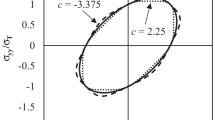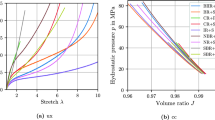Abstract
A method for describing the creep behavior until fracture of a highly filled polymer material previously damaged in preliminary tests is proposed. The constitutive relations are the relations of nonlinear endochronic theory of aging viscoelastic materials (NETAVEM) [1]. The numerical-graphical method for identifying the functions occurring in NETAVEM, which was proposed in [2] for describing loading processes at a constant strain rate, is used here for the first time in creep theory. We use the results of experiments with undamaged and preliminary damaged specimens under the action of the same constant tensile loads. The creep kernel is determined in experiments with an undamaged specimen. The reduced time function contained in NETAVEM is determined from the position of points corresponding to the same values of strain on the creep curves of the damaged and undamaged specimens. An integral equation is solved to obtain the aging function, and then the viscosity function is determined. The knowledge of all functions contained in the constitutive relations permits solving the creep problem for products manufactured from a highly filled polymer material.
Similar content being viewed by others
References
D. L. Bykov, “Utilization of Structural Components of SpecificWork of Internal Forces for the Description of Strength of Viscoelastic Materials,” Izv. Akad. Nauk.Mekh. Tverd. Tela, No. 3, 99–111 (2003) [Mech. Solids (Engl. Transl.) 38 (3), 78–87 (2003)].
D. L. Bykov and E. D. Martynova, “Numerical-Graphical Method for Determining Characteristics of Damaged Viscoelastic Materials,” Izv. Akad. Nauk. Mekh. Tverd. Tela, No. 4, 64–71 (2013) [Mech. Solids (Engl. Transl.) 48 (4), 410–416 (2013)].
A. A. Il’yushin and B. E. Pobedrya, Foundations of Mathematical Theory of Thermoviscoelasticity (Nauka, Moscow, 1970) [in Russian].
A. V. Manzhirov and A. D. Polyanin, Methods for Solving Integral Equations. Reference Book (Faktorial, Moscow, 1999) [in Russian].
Author information
Authors and Affiliations
Corresponding author
Additional information
Original Russian Text ©D.L. Bykov, E.D. Martynova, V.P. Mel’nikov, 2015, published in Izvestiya Akademii Nauk. Mekhanika Tverdogo Tela, 2015, No. 5, pp. 108–115.
About this article
Cite this article
Bykov, D.L., Martynova, E.D. & Mel’nikov, V.P. Numerical-graphical method for describing the creep of damaged highly filled polymer materials. Mech. Solids 50, 571–577 (2015). https://doi.org/10.3103/S0025654415050088
Received:
Published:
Issue Date:
DOI: https://doi.org/10.3103/S0025654415050088




